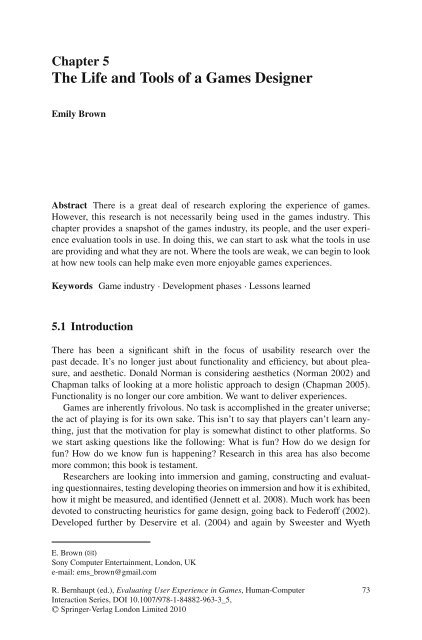Evaluating User Experience in Games: Concepts and Methods - Lirmm
Evaluating User Experience in Games: Concepts and Methods - Lirmm
Evaluating User Experience in Games: Concepts and Methods - Lirmm
Create successful ePaper yourself
Turn your PDF publications into a flip-book with our unique Google optimized e-Paper software.
Chapter 5<br />
The Life <strong>and</strong> Tools of a <strong>Games</strong> Designer<br />
Emily Brown<br />
Abstract There is a great deal of research explor<strong>in</strong>g the experience of games.<br />
However, this research is not necessarily be<strong>in</strong>g used <strong>in</strong> the games <strong>in</strong>dustry. This<br />
chapter provides a snapshot of the games <strong>in</strong>dustry, its people, <strong>and</strong> the user experience<br />
evaluation tools <strong>in</strong> use. In do<strong>in</strong>g this, we can start to ask what the tools <strong>in</strong> use<br />
are provid<strong>in</strong>g <strong>and</strong> what they are not. Where the tools are weak, we can beg<strong>in</strong> to look<br />
at how new tools can help make even more enjoyable games experiences.<br />
Keywords Game <strong>in</strong>dustry · Development phases · Lessons learned<br />
5.1 Introduction<br />
There has been a significant shift <strong>in</strong> the focus of usability research over the<br />
past decade. It’s no longer just about functionality <strong>and</strong> efficiency, but about pleasure,<br />
<strong>and</strong> aesthetic. Donald Norman is consider<strong>in</strong>g aesthetics (Norman 2002) <strong>and</strong><br />
Chapman talks of look<strong>in</strong>g at a more holistic approach to design (Chapman 2005).<br />
Functionality is no longer our core ambition. We want to deliver experiences.<br />
<strong>Games</strong> are <strong>in</strong>herently frivolous. No task is accomplished <strong>in</strong> the greater universe;<br />
the act of play<strong>in</strong>g is for its own sake. This isn’t to say that players can’t learn anyth<strong>in</strong>g,<br />
just that the motivation for play is somewhat dist<strong>in</strong>ct to other platforms. So<br />
we start ask<strong>in</strong>g questions like the follow<strong>in</strong>g: What is fun? How do we design for<br />
fun? How do we know fun is happen<strong>in</strong>g? Research <strong>in</strong> this area has also become<br />
more common; this book is testament.<br />
Researchers are look<strong>in</strong>g <strong>in</strong>to immersion <strong>and</strong> gam<strong>in</strong>g, construct<strong>in</strong>g <strong>and</strong> evaluat<strong>in</strong>g<br />
questionnaires, test<strong>in</strong>g develop<strong>in</strong>g theories on immersion <strong>and</strong> how it is exhibited,<br />
how it might be measured, <strong>and</strong> identified (Jennett et al. 2008). Much work has been<br />
devoted to construct<strong>in</strong>g heuristics for game design, go<strong>in</strong>g back to Federoff (2002).<br />
Developed further by Deservire et al. (2004) <strong>and</strong> aga<strong>in</strong> by Sweester <strong>and</strong> Wyeth<br />
E. Brown (B)<br />
Sony Computer Enterta<strong>in</strong>ment, London, UK<br />
e-mail: ems_brown@gmail.com<br />
R. Bernhaupt (ed.), <strong>Evaluat<strong>in</strong>g</strong> <strong>User</strong> <strong>Experience</strong> <strong>in</strong> <strong>Games</strong>, Human-Computer<br />
Interaction Series, DOI 10.1007/978-1-84882-963-3_5,<br />
C○ Spr<strong>in</strong>ger-Verlag London Limited 2010<br />
73

















